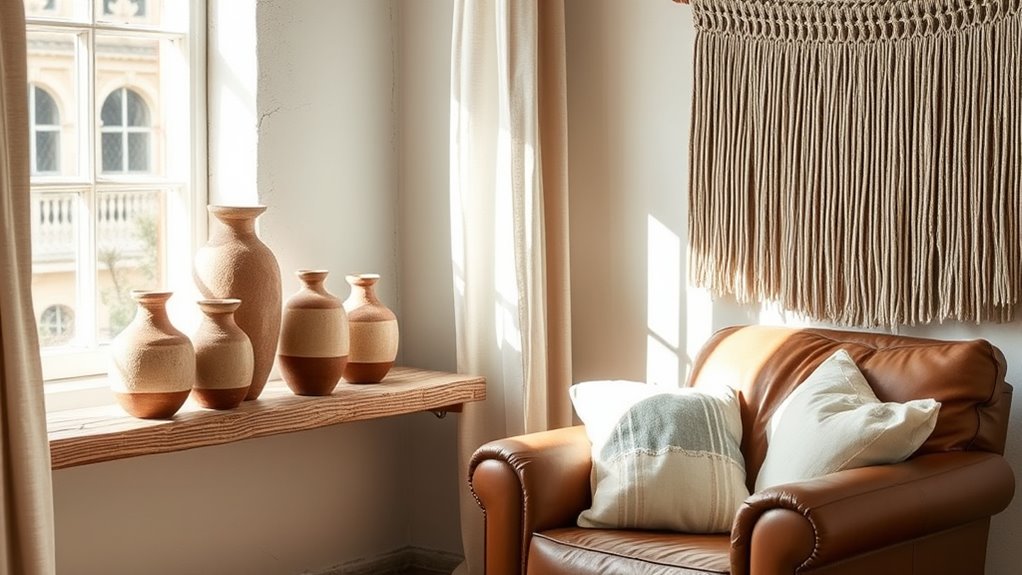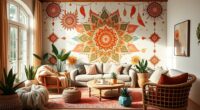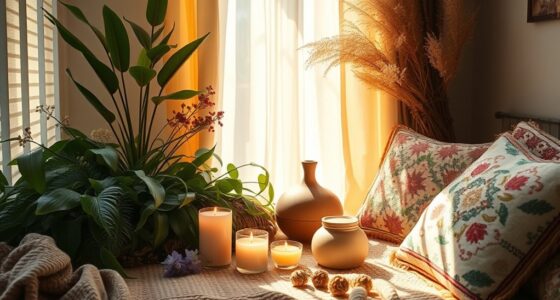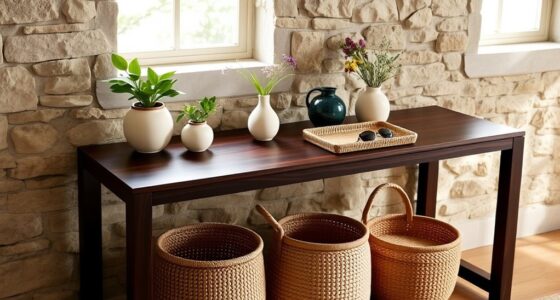By blending wabi-sabi and boho styles, you create a cozy space that celebrates imperfection and authenticity. Focus on natural materials like wood, linen, and stone, and incorporate handcrafted and vintage pieces for character. Embrace asymmetry, weathered finishes, and layered textures to add depth. Use warm lighting, greenery, and personal touches to foster a calming, imperfect charm. Keep exploring to discover how to fully curate this harmonious, soulful aesthetic in your home.
Key Takeaways
- Combine natural materials and textures from both styles to create authentic, layered, and tactile home environments.
- Embrace imperfections through handcrafted, aged, or distressed decor that highlight natural beauty and uniqueness.
- Balance neutral earthy palettes with vibrant boho accents for a harmonious, relaxed atmosphere.
- Incorporate vintage, heirloom, and DIY pieces that tell personal stories and add character.
- Use soft, warm lighting and organic shapes to enhance a cozy, tranquil, and imperfectly perfect space.
The Foundations of Wabi-Sabi and Boho Aesthetics
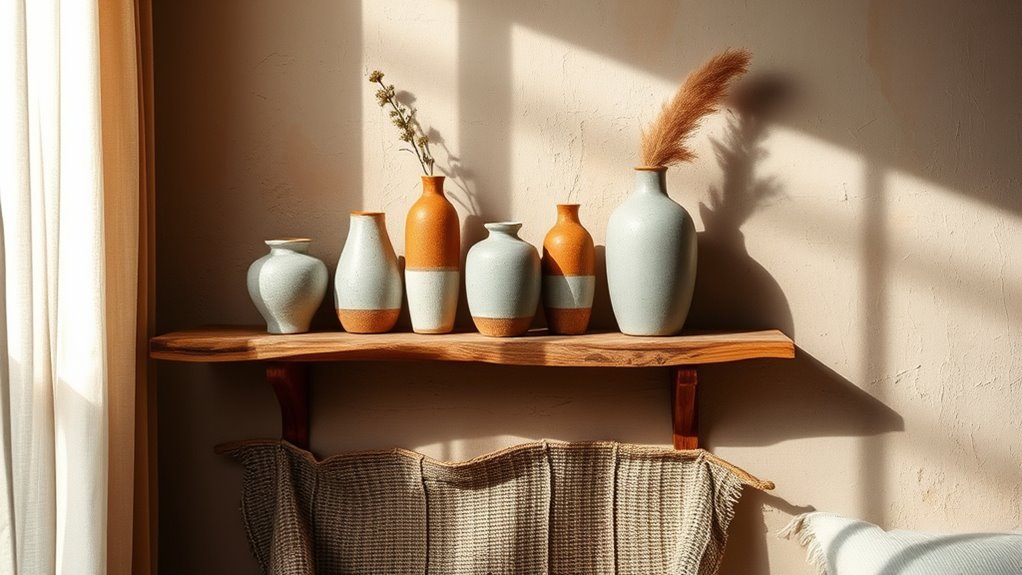
Both wabi-sabi and boho aesthetics draw on a deep appreciation for authenticity and individuality, though they approach these values in different ways. Wabi-sabi celebrates imperfection, valuing natural aging, flaws, and transience in objects and design. It emphasizes simplicity and the beauty of things that show their history. Incorporating aesthetic principles can help curate and optimize content that highlights these unique qualities, making the themes more accessible to a broader audience. Boho, on the other hand, is eclectic and globally inspired, layering textures, patterns, and handmade details to create a vibrant, personal space. Both styles prioritize natural materials like wood, rattan, jute, and stone, which enhance their authentic feel. Wabi-sabi’s neutral, earthy palette complements boho’s richer tones, making their combination harmonious. Incorporating contrast ratio considerations can further enhance the visual harmony of a space, ensuring that lighting and textures work together to highlight their unique qualities. Understanding material authenticity helps in selecting pieces that genuinely embody these styles, fostering an environment that feels both lived-in and thoughtfully curated.
Harmonizing Neutral Tones and Earth-Inspired Palettes
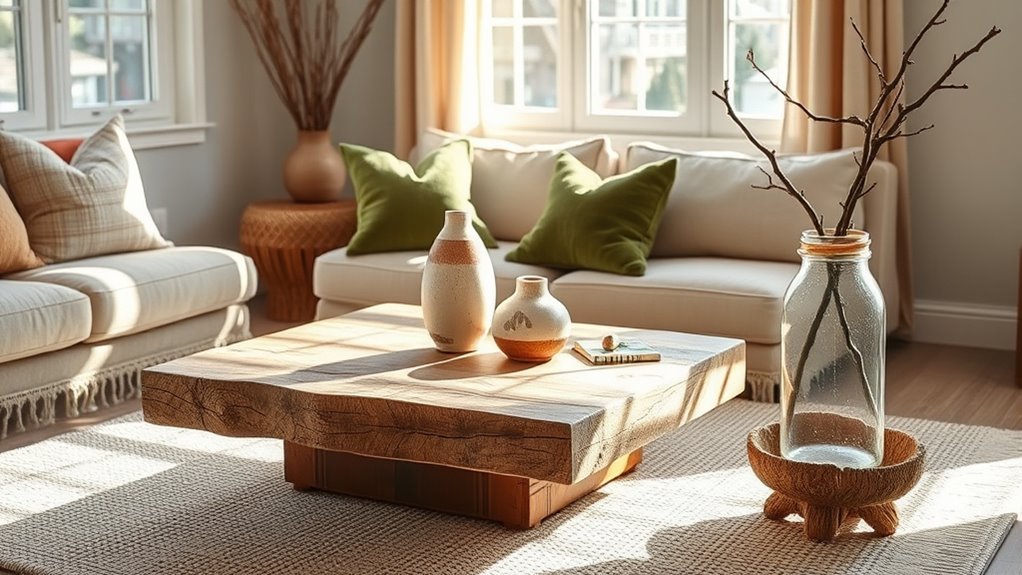
As you blend the natural beauty of wabi-sabi with boho’s vibrant layers, harmonizing neutral tones and earth-inspired palettes becomes key to creating a cohesive space. Start with neutral palettes like beige, taupe, and soft greys for a calming, unobtrusive background that fosters serenity. Incorporate earth-inspired colors such as terracotta, olive green, and warm browns as accents to evoke a grounded, natural vibe. These muted, earthy tones work beautifully with organic materials like wood, stone, and linen, emphasizing authenticity and imperfection. Mixing these elements creates a balanced environment where subtle jewel hues add depth without overpowering the simplicity. This approach celebrates natural aging and wear, resulting in a tranquil space that seamlessly marries wabi-sabi’s imperfection with boho’s layered richness. Exploring beach destinations can inspire a relaxed, natural aesthetic that complements this decor style. Recognizing the importance of natural materials enhances the authenticity and tactile appeal of your decor. Incorporating textural variety through woven textiles, rattan, and ceramics further enriches the layered, imperfect charm characteristic of boho-wabi decor. Additionally, understanding the authenticity of materials helps in selecting pieces that truly embody the natural, imperfect beauty central to this style, while sound healing science offers insights into creating a calming atmosphere that enhances the overall serenity of your space.
Embracing Texture: Natural Materials and Handcrafted Elements
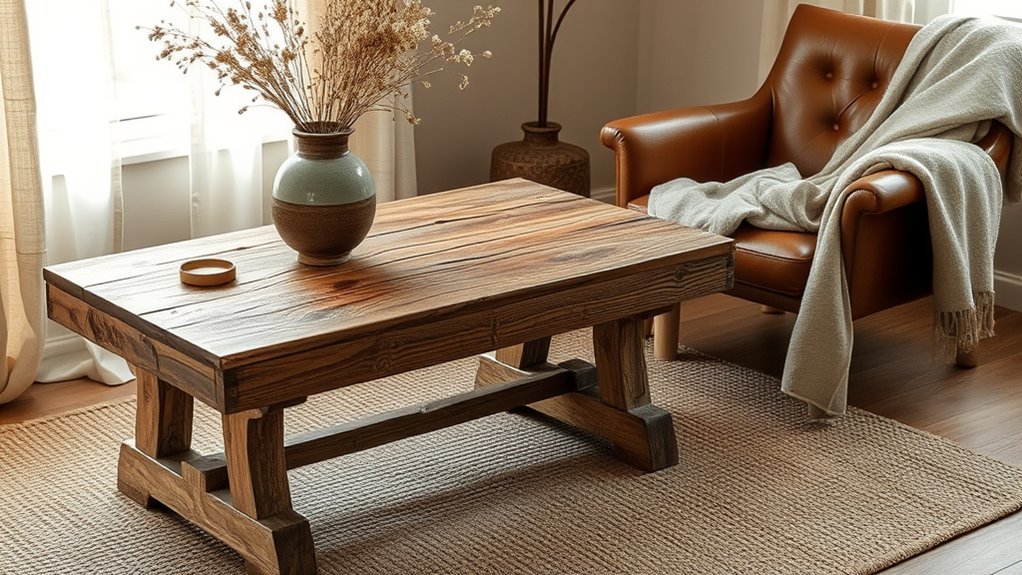
You can create a cozy, authentic space by choosing natural materials like jute, linen, and raw wood that bring organic textures to life. Handcrafted pieces, such as woven wall hangings and handmade pottery, add unique imperfection and artistry. Layering these textures with weathered finishes and uneven surfaces enhances tactile richness and celebrates natural flaws. Additionally, incorporating cost-effective production methods for decor elements can help maintain an authentic aesthetic while managing budget constraints. Embracing sustainable practices in sourcing and creating decor can further deepen the connection to natural imperfection and environmental consciousness.
Organic Textures and Materials
In Wabi-Sabi Boho interiors, embracing organic textures means choosing natural materials like jute, linen, raw wood, and clay that invite touch and foster authenticity. These organic materials add warmth and depth, creating a calming, grounding atmosphere. Using natural textures helps you connect with nature and celebrate imperfection, which is central to Wabi-Sabi. Handcrafted elements, such as handmade ceramics and woven wall hangings, enhance this effect by emphasizing uniqueness and individual artistry. Materials with visible imperfections—distressed wood or uneven ceramics—highlight natural aging and authenticity. Incorporating raw, unpolished finishes and natural fibers results in a layered, textured environment that embodies the impermanent beauty of Wabi-Sabi and boho aesthetics, making your space feel genuine and welcoming.
Handcrafted and Imperfect Details
Handcrafted and imperfect details bring warmth and character to Wabi-Sabi Boho interiors by showcasing the beauty of artisanal craftsmanship. You’ll notice irregular shapes, subtle cracks, and uneven edges that celebrate authenticity and individuality. Natural materials like jute, linen, and raw wood develop unique textures and patinas over time, embodying the Wabi-Sabi appreciation for aging. Incorporating handmade elements invites touch, fostering a tactile connection with each piece. Imagine these textures and imperfections creating a layered, inviting space: Ideal conditions for growing organic materials and creating an authentic, natural aesthetic.
Curating Meaningful Decor With Personal Significance
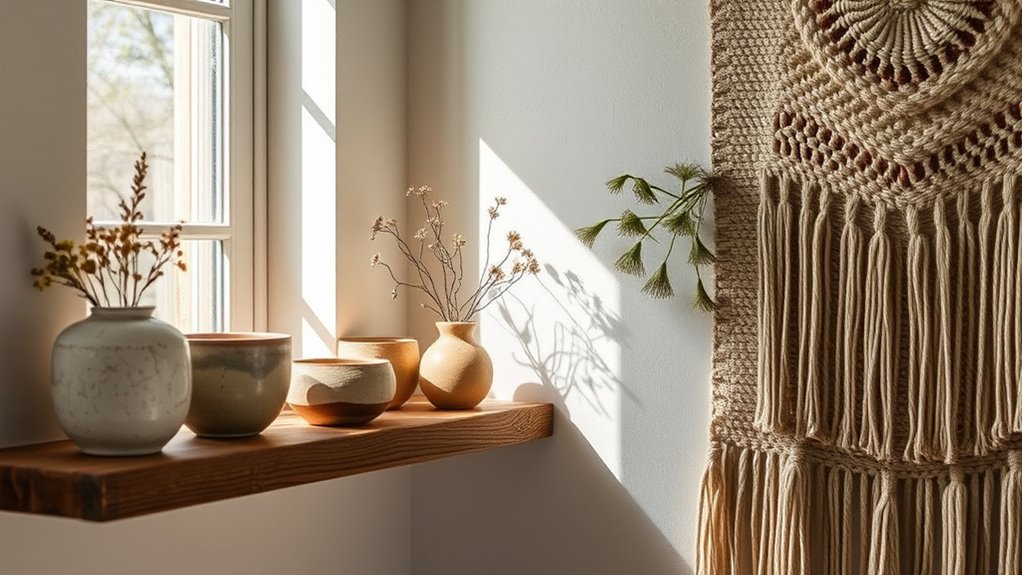
To create a space that feels authentic and rich with meaning, focus on curating decor that holds personal significance. Seek out vintage, heirloom, or handmade pieces that tell your unique story, adding depth and authenticity to your home. Prioritize quality and craftsmanship over quantity, choosing items that evoke emotion and have meaningful origins. Incorporate repurposed or DIY projects to craft organic accents reflecting your personality and craftsmanship. Embrace decor with visible imperfections, like uneven glazing or natural patinas, to celebrate authenticity and wabi-sabi principles. Curate a collection of objects that evoke nostalgia or personal memories, fostering a deeper connection to your space. Incorporating sustainable fabrics and eco-friendly materials can also enhance the authenticity and mindful nature of your decor choices. Exploring handcrafted decor items adds a layer of uniqueness and supports artisans committed to sustainable practices. Paying attention to design with imperfection helps you embrace the beauty of natural variations and irregularities, aligning beautifully with wabi-sabi ideals. Additionally, understanding relationships and personality traits can inspire intentional choices that reflect your inner values. For example, selecting decor that emphasizes natural materials can further enhance the organic and imperfect aesthetic. By selecting meaningful decor, you create a home that truly resonates with your identity and values.
Celebrating Asymmetry and Imperfection in Furniture and Art
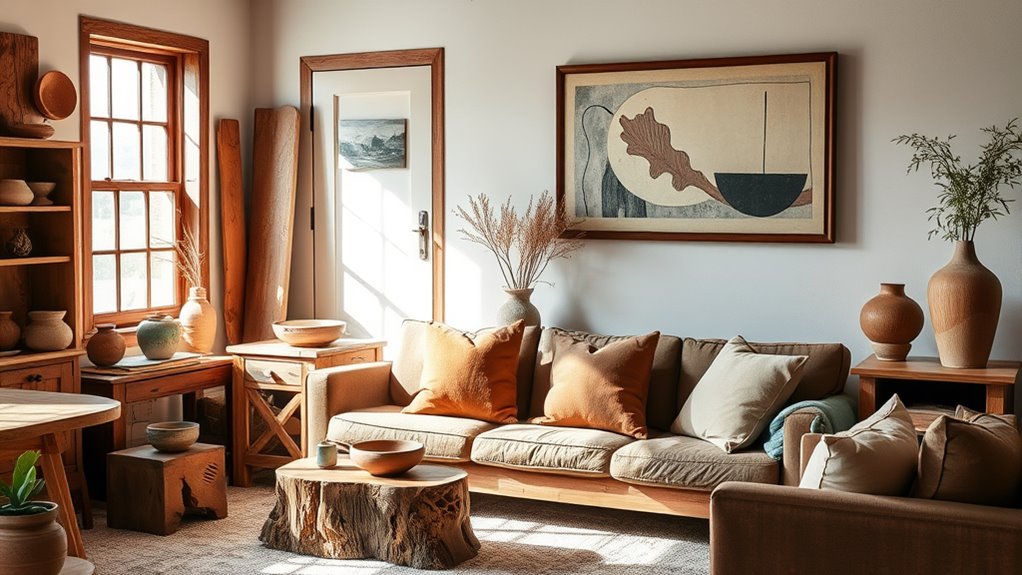
Embracing asymmetry and imperfection in furniture and art allows you to celebrate the natural beauty of handcrafted pieces. These elements highlight organic, imperfect shapes that evoke authenticity and character. You might incorporate mismatched furniture, such as unevenly paired chairs or irregular ceramics, which emphasize the Wabi-Sabi appreciation for imperfection. Artworks hung slightly off-center or with uneven framing create visual interest and reflect beauty in flaws. This intentional embrace fosters a sense of tranquility and personality in your space. To achieve this, consider:
- Using handcrafted furniture with irregular shapes
- Displaying mismatched or unevenly paired pieces
- Hanging art slightly off-center for visual intrigue
- Showcasing one-of-a-kind, imperfect art or decor
- Being mindful of IRA tax implications when planning your decor investments, especially if you consider resale or value appreciation of your unique pieces. Additionally, incorporating biodiversity-friendly decor elements, such as natural materials and sustainable sourcing, can further enhance the authenticity and eco-consciousness of your design. Recognizing the financial impact of entertainment industry insights can also guide you in selecting pieces that hold or increase their value over time. Understanding tangible assets can help you make more informed decisions about investing in unique decor items that appreciate in worth. Moreover, exploring celebrity transformations in interior style can inspire personalized and trendy decor choices that reflect current aesthetic shifts.
Creating Balance With Space, Light, and Negative Areas
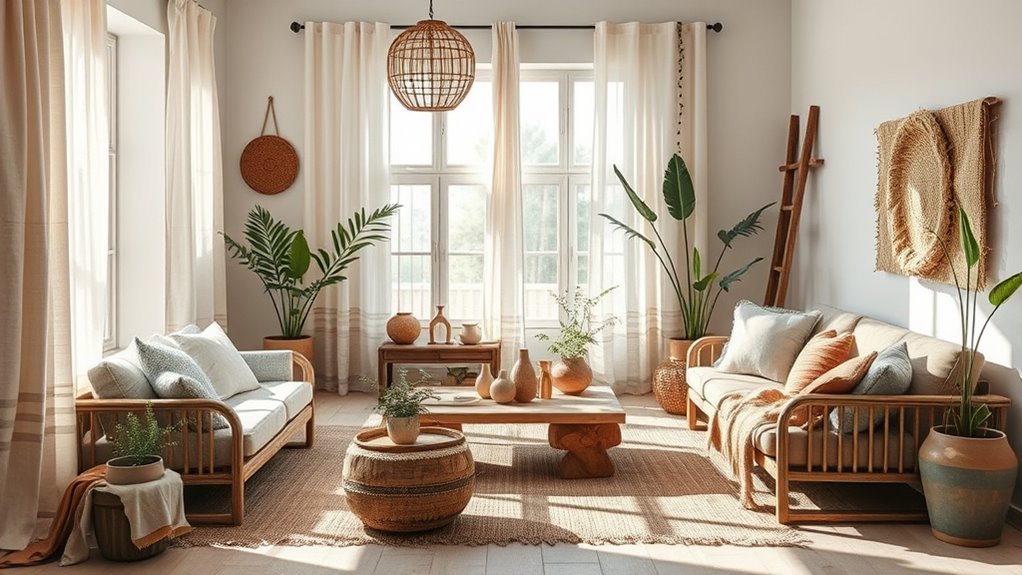
Creating balance in a Wabi-Sabi boho space involves thoughtfully managing space, light, and negative areas to cultivate a sense of calm and harmony. Negative space is key—leaving areas intentionally uncluttered allows your room to breathe and promotes serenity. Use natural light to highlight these open zones, amplifying their peaceful effect. Incorporate simple, understated decor in negative spaces to avoid visual overload and maintain cohesion. Balance textured, imperfect furnishings with airy zones to emphasize beauty through contrast. Strategically position furniture and decor to guide your eye smoothly across the space. Incorporating low light office plants can further enhance the tranquil atmosphere by adding subtle greenery without overwhelming the space. Additionally, understanding the importance of visual balance can help you create a more harmonious and inviting environment.
Combining Vintage and Modern Pieces for a Curated Look
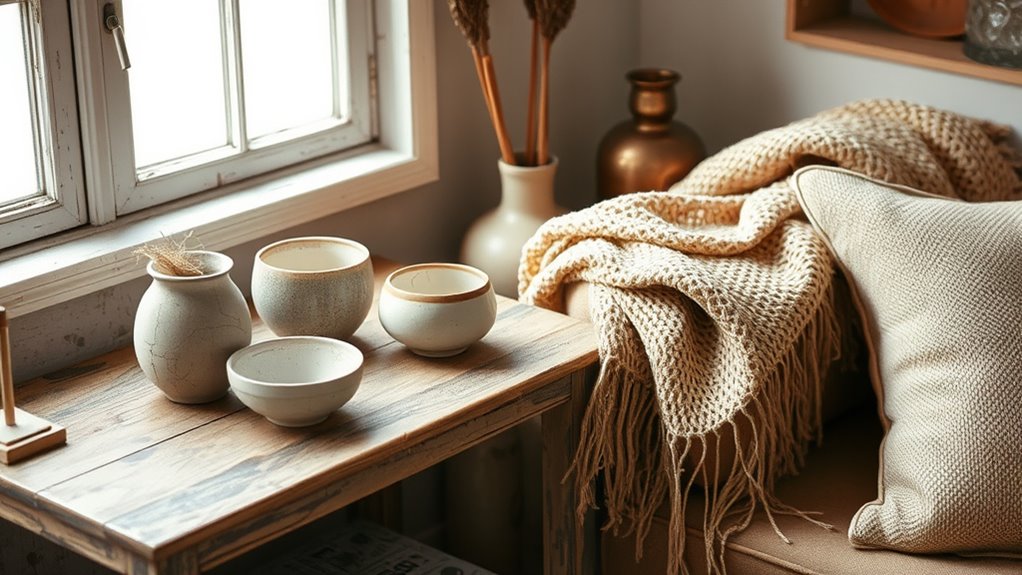
Blending vintage and modern pieces adds depth and personality to a Wabi-Sabi boho space, enriching its curated feel. You can achieve an eclectic aesthetic by pairing weathered wooden tables or vintage ceramics with sleek, contemporary accents. Incorporate antique finds alongside minimalistic lighting fixtures or modern art to highlight the beauty of imperfection. Use contrasting textures, like distressed wood and smooth glass or metal, to emphasize harmony between old and new. Curate a collection of handcrafted vintage items mixed with intentionally imperfect modern decor to evoke a sense of curated impermanence. Focus on meaningful, story-driven pieces that reflect your personality. This approach creates a space where vintage charm and modern simplicity coexist, celebrating imperfection and authenticity in every detail. Additionally, understanding the role of AI in retail success can inspire innovative ways to personalize your space through smart design tools and data-driven insights. Incorporating remote collaboration tools can also help gather inspiration from a diverse range of sources, ensuring your decor remains fresh and unique. To further enhance your decor, regularly assessing and rotating your pieces can help maintain a balanced and inspiring environment, aligning with home organization principles for a harmonious home.
Crafting a Cozy Atmosphere With Warm, Ambient Lighting
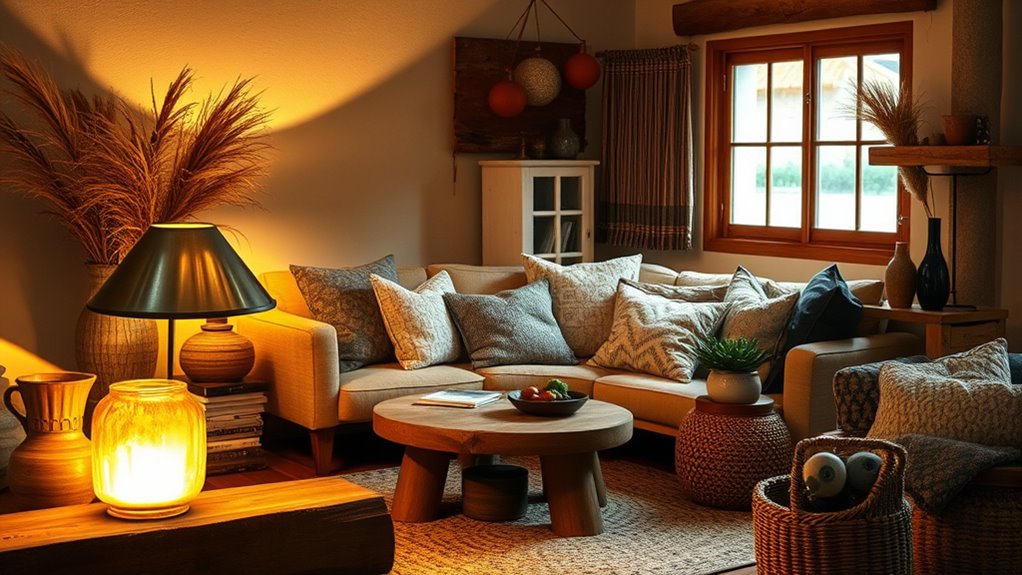
To cultivate a cozy, inviting atmosphere in your Wabi-Sabi boho space, focus on using warm, ambient lighting that softens the overall vibe. Choose warm-colored bulbs, like soft white or amber tones, to create a welcoming glow. Incorporate natural materials such as wooden or linen-shaded lamps and paper lanterns, which enhance the organic, imperfect aesthetic. Opt for dimmable fixtures to easily adjust the mood and promote relaxation throughout the day. Avoid harsh, cool white LEDs; instead, select fixtures that emit a gentle, diffused glow, adding subtle warmth to your decor. Place lighting thoughtfully to highlight textured decor and handmade objects, emphasizing the imperfect beauty of natural materials and cultivating a soothing, ambient atmosphere in your space.
Incorporating Greenery and Organic Shapes for Natural Flow
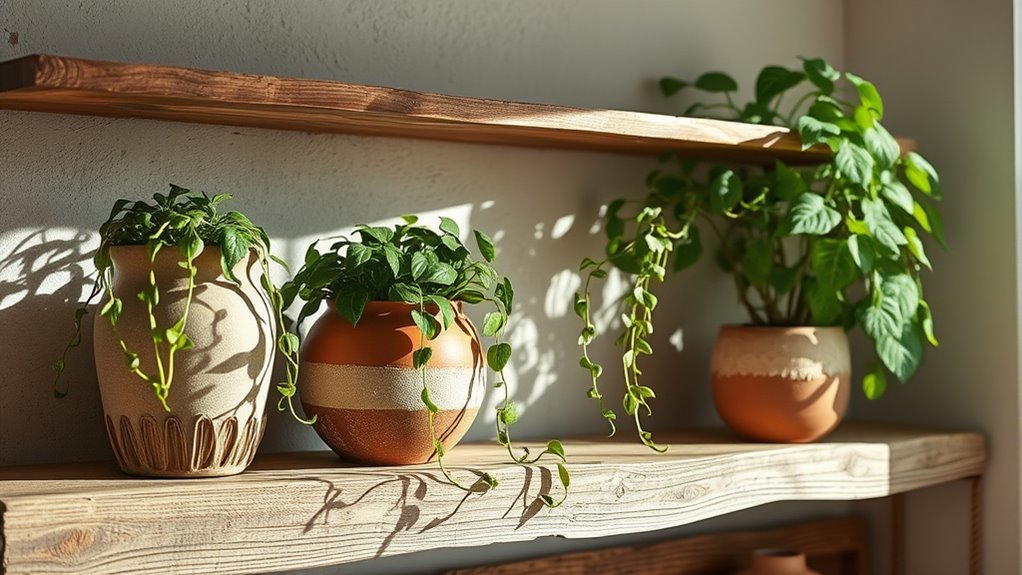
Building on the warm, inviting glow of your lighting setup, incorporating greenery and organic shapes enhances the natural flow of your Wabi-Sabi boho space. You can achieve this by choosing planters with organically curved forms, made from unglazed clay or woven baskets, to emphasize natural materials. Lush, slightly unruly greenery like snake plants, eucalyptus, or pothos adds a wild, imperfect touch. Select furniture with curved, flowing lines and asymmetrical designs that mimic organic forms found in nature. To create a relaxed, harmonious vibe, arrange plants and decor in loose, unstructured groupings. This approach highlights the beauty of imperfection and enhances the natural flow of your space. Incorporating greenery and organic shapes fosters an authentic, calming environment rooted in natural materials and forms.
Personal Touches and DIY Elements for Authenticity
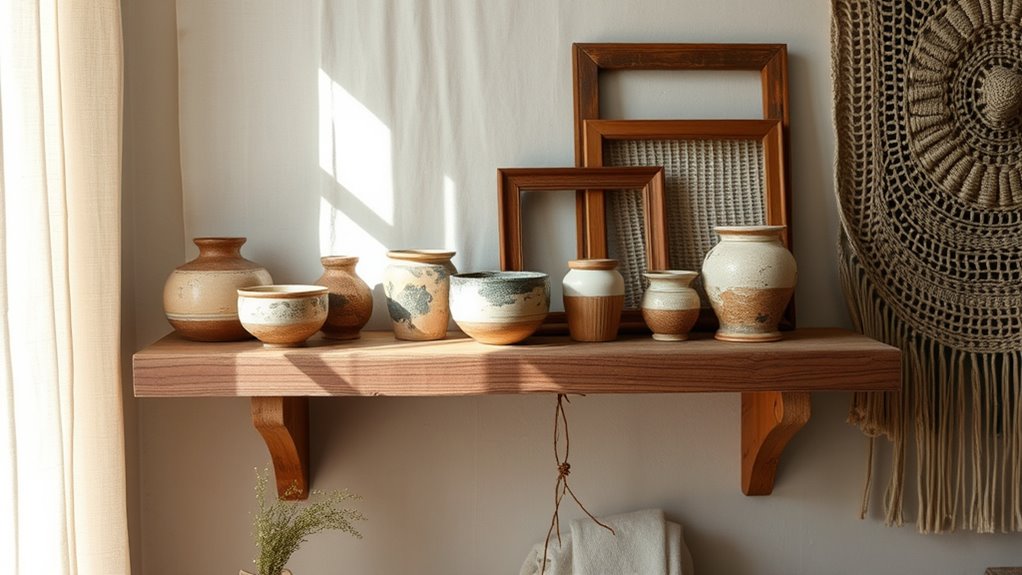
Adding personal touches and DIY elements brings authentic charm to your Wabi-Sabi boho space. Handmade items like painted vases or stitched pillows showcase personal authenticity, making your decor uniquely yours. DIY projects, such as reclaimed wood shelves or painted ceramics, add imperfect beauty that highlights craftsmanship and effort. Display meaningful objects like vintage heirlooms or travel souvenirs to tell your story. Incorporate this table for inspiration:
| Item Type | Example | Significance |
|---|---|---|
| Handmade decor | Stitched pillows | Personal authenticity |
| DIY furniture | Reclaimed wood shelves | Unique, imperfect charm |
| Personal objects | Travel souvenirs | Tells your story, adds character |
| Repurposed items | Painted vases | Eco-friendly, handcrafted |
| Seasonal updates | Fresh handmade ornaments | Keeps space authentic and lively |
Incorporate these ideas to craft a space full of meaningful, imperfect beauty.
Frequently Asked Questions
What Is Wabi-Sabi Home Decor?
Wabi-sabi home decor celebrates imperfection, natural aging, and authenticity. You’ll find raw textures, asymmetry, and handmade elements that create a sense of tranquility. Think earthy, muted tones like beige and taupe, with weathered wood, unglazed ceramics, and organic fibers. It emphasizes simplicity and minimalism, focusing on quality and storytelling objects. By embracing rustic, antique pieces, you craft a warm, authentic space that highlights beauty in imperfection and impermanence.
What Are the Three Principles of Wabi-Sabi?
Think of Wabi-Sabi as a garden where nature’s beauty blooms through flaws. Its three core principles are imperfection, emphasizing the beauty of asymmetry and flaws; impermanence, reminding you that everything is transient and should be appreciated; and simplicity, encouraging minimalism and natural materials. These principles guide you to embrace authenticity, find tranquility, and celebrate the beauty in life’s fleeting, imperfect moments.
What Is the Meaning of Wabi-Sabi Imperfection?
You might wonder what wabi-sabi imperfection means. It’s about seeing beauty in flaws, irregularities, and signs of age. Instead of aiming for perfection, you embrace natural textures, asymmetry, and handmade details. This perspective helps you appreciate authenticity and character in your home. By accepting imperfection, you foster mindfulness, gratitude, and a deeper connection to the transient, imperfect beauty in everyday life and decor.
What Are the Rules of Wabi-Sabi Interior Design?
Did you know that 70% of people find comfort in imperfect, authentic spaces? In wabi-sabi interior design, you embrace asymmetry, natural materials, and aged textures, avoiding clutter for a calming atmosphere. Focus on handmade, meaningful items, and use soft, warm lighting to highlight imperfections. Keep your space minimalist, intentional, and personal—letting the beauty of imperfection create a serene, authentic environment that reflects your unique story.
Conclusion
By blending wabi-sabi with boho, you create a space that’s beautifully imperfect and uniquely yours. Embrace the idea that flaws add character, turning your home into a cozy haven filled with meaningful, handcrafted pieces. Think of it as a way to celebrate life’s natural flow—proving that authenticity and charm often come from embracing imperfection. Your home isn’t just a space; it’s a reflection of your genuine, vibrant spirit.
